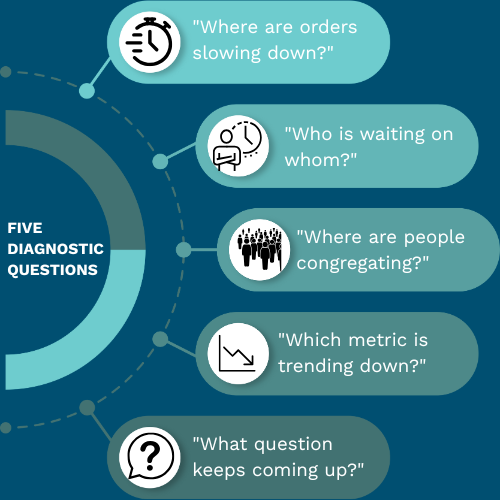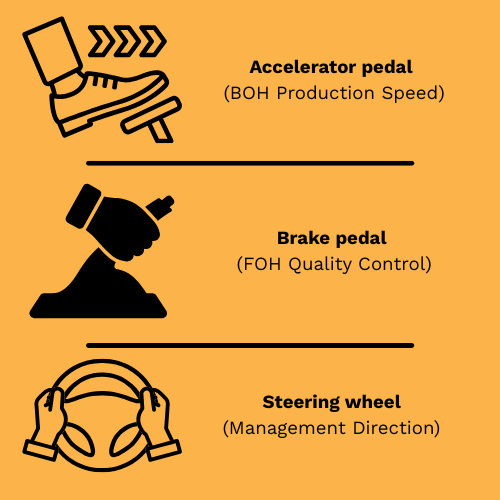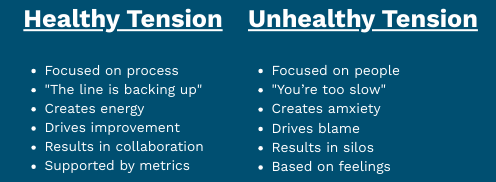The Power of Healthy Tension: Mastering Bottlenecks in Restaurant Operations
It's 12:15pm, and you're watching drive-thru times spike, bags stack up, and your headset chatter crescendos. Orders are backing up while guests become impatient. You're not failing—you've just found today's bottleneck. What you do next defines the culture of your shift—whether it's reactive or intentional, panicked or process-driven.
The Bottom Line
Restaurant excellence isn't about eliminating operational pressure—it's about channeling it productively. Leaders who embrace "healthy tension" transform inevitable bottlenecks into drivers of continuous improvement, delivering measurable gains in speed, accuracy, and guest satisfaction.
Understanding the Pipeline Principle
Think of your restaurant as a pipeline system. When water flows through pipes, pressure will always find and expose the weakest point. Similarly, in operations, pressure will always identify your current constraint. Fix one leak, and the pressure simply moves elsewhere.
Every restaurant operation, no matter how well-designed, will always have a bottleneck—that critical point where the flow of production slows down. This operational reality isn't a failure but rather a natural consequence of any complex system.
The key insight: Bottlenecks don't disappear—they migrate. When you solve one bottleneck, the constraint inevitably shifts elsewhere in the system. This "pipeline principle" fundamentally changes how effective leaders approach operations management.
Spotting Bottlenecks: A Practical Diagnostic Framework
Great leaders don't wait for bottlenecks to become obvious. They proactively hunt for them using these diagnostic questions:
Where are orders slowing down? (Look for accumulating tickets or digital orders)
Who is waiting on whom? (Notice which station or position is being waited on)
Where are people congregating? (Staff naturally cluster around bottlenecks)
Which KPI is trending down? (Speed metrics often reveal bottlenecks before they're visible)
What question keeps coming up? ("Where are those nuggets?" signals a bottleneck)
Try This: Implement a visual system:
Green: Flowing smoothly
Yellow: Building pressure
Red: Critical constraint
This common language allows every Team Member to communicate issues quickly—without blame or confusion. Stations can self-report their status, and managers can see at a glance where to direct support.
The Nugget Scenario: Bottlenecks in Action and Response
Consider this scenario: Back-of-House runs out of nuggets because they didn't anticipate demand correctly. This creates an immediate bottleneck at the secondary, where orders back up because the chutes are empty.
How bottlenecks migrate:
Secondary (Initial Bottleneck): Orders back up waiting for nuggets
Bagging (Secondary Bottleneck): Once nuggets are up, Front-of-House must catch up on delayed orders
Outside Meal Delivery (Tertiary Bottleneck): After bagging catches up, expeditors scramble to deliver meals to waiting guests
How effective leaders respond:
In-the-moment response: "Team, nuggets are our bottleneck right now. Kitchen, I need an ETA. Front Counter, let's communicate wait times. Drive-thru, let's park any cars that are blocking other customers."
Post-shift debrief: "Let's walk the bottleneck—where did it begin, how did it move, and what could we do upstream to prevent it next time? This isn't about blame—it's about flow."
Creating Purposeful Tension: The Accelerator and Brake Model
Think of healthy tension like driving a car—you need an accelerator and a brake to move efficiently. In restaurant operations:
Back-of-House is often the accelerator: Producing food quickly and consistently
Front-of-House typically functions as the brake: Ensuring accuracy and guest satisfaction
Management is the steering wheel: Guiding the balance between speed and quality
The reality is more fluid, though—both teams take turns pressing and easing pressure depending on where the bottleneck resides. During a rush, FOH might accelerate by increasing order volume with more Order Takers, while BOH applies the brake if capacity is stretched (slowed assembly time). The roles constantly shift, like rowers in sync, adjusting their stroke to navigate changing currents.
When these forces work in harmony, creating deliberate pressure on each other, the restaurant achieves optimal performance. The key is role clarity—everyone must understand their job and how their pace affects others.
Distinguishing Healthy vs. Unhealthy Tension
Coaching language for leaders:
"Let's attack the problem, not each other."
"This isn't about blame—it's about flow."
"Where's our constraint right now, and how can we support that area?"
"I need your best right now, not your fastest."
Systems for Managing Bottlenecks
Effective bottleneck management requires structured communication systems:
Pre-shift huddles: Anticipate potential bottlenecks based on forecasts
Rush check-ins: Quick 15-second updates during peak periods
Visual indicators: Simple signals that show where pressure is building
Post-shift reviews: Analyze how bottlenecks formed and shifted
Weekly trend analysis: Identify patterns in recurring bottlenecks
Sample Pre-Shift Huddle Script: "Today we're expecting heavy volume from 12-2. Based on yesterday, our likely bottleneck will start on boards. BOH, you'll need to stay ahead on all protein. When that bottleneck shifts—and it will—it'll probably hit bagging next. Drive-Thru, be ready to flex additional support there."
Acute vs. Chronic Bottlenecks: Different Solutions
Not all bottlenecks are created equal. Leaders must distinguish between:
Acute Bottlenecks
Characteristics: Temporary, situation-specific, often unpredictable
Example: Running out of nuggets during an unexpected rush
Solution Approach: Real-time tactical adjustments, flex staffing, substitutions
Ownership: Shift leaders, team members
Chronic Bottlenecks
Characteristics: Recurring, predictable, often equipment or design-related
Example: Machines are down due to not filtering in time during every lunch rush
Solution Approach: Process redesign, new systems, and different setup plays
Ownership: Management, operations teams
The distinction matters because applying acute solutions to chronic problems (like constantly flexing staff to a predictably understaffed station) creates unnecessary stress and fails to address root causes.
Measuring the Impact: Connecting to Business Metrics
Effective bottleneck management directly impacts metrics:
Speed of Service: improvement when bottlenecks are actively managed
Order Accuracy: improvement when pressure is properly distributed (measured by reduction in remakes and customer complaints)
Labor Efficiency: improvement through better allocation of resources
Guest Satisfaction: improvement when wait times are consistently met
Track these metrics before and after implementing healthy tension principles to demonstrate ROI on this operational approach.
Want to track these numbers intentionally? Build a simple dashboard tracking:
Daily average Speed of Service by daypart
Number of order corrections, substitutions, or modifications
Overall Satisfaction score
Voice of customer feedback on Fast Service from CEMs (Customer Feedback)
Labor cost percentage against sales
Even a simple whiteboard with three tracking columns—"Yesterday's Numbers," "Today's Goal," and "Current Performance"—can transform how your team views bottlenecks.
Building a Culture of Healthy Tension
Great operators don't just manage bottlenecks—they build organizational cultures where bottleneck awareness is second nature:
Train for cross-functionality: Ensure team members can support multiple stations
Recognize bottleneck-solving: Celebrate teams that effectively manage constraints
Model blame-free language: Consistently demonstrate process-focused communication
Include bottleneck awareness in development plans: Make it part of leadership advancement
Cultural mantra: "Find the constraint, support the constraint, solve the constraint, find the next one."
Bottlenecks are not problems to hide—they're insights to share. This mindset shift alone builds psychological safety and accelerates team development.
Conducting the Symphony: Leading Through Tension
Restaurant operations excellence isn't about achieving static perfection—it's about conducting a symphony where tension between sections creates harmony rather than discord.
The most successful operations embrace this reality, using healthy tension as a tool rather than viewing it as an obstacle. In this environment, bottlenecks aren't problems to eliminate once and for all, but signposts guiding you toward your next opportunity for operational excellence.
When your team understands that operational pressure is not just inevitable but valuable, they stop fighting the current and start directing it. That's when a restaurant transforms from a collection of positions into a unified system that delivers consistent guest experiences, stronger financial results, and a more satisfying work environment.
The true power of healthy tension lies in creating a culture that thrives on identifying, addressing, and shifting constraints—all in service of something greater: extraordinary guest experiences delivered through exceptional operational performance.
Because in restaurants, harmony isn't just beautiful—it's profitable.
Action Step: At your next shift, try this simple exercise: Identify your current bottleneck, make one change to address it, then watch where the pressure moves next. Track the impact on your Speed of Service and Overall Satisfaction, and use this data to start a conversation about healthy tension with your team.






